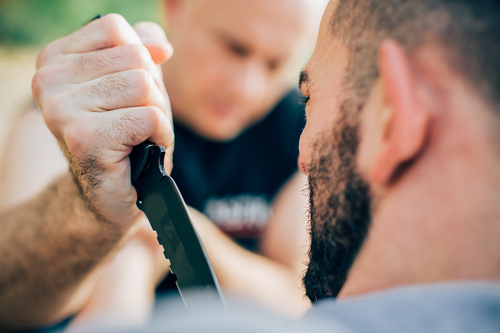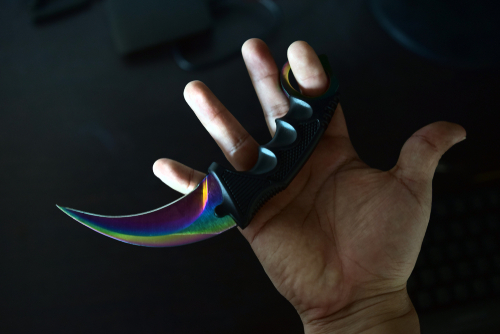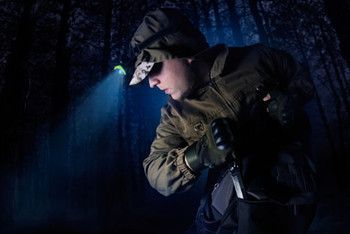Knife Fighting with Custom Survival Knives: Four Things to Keep in Mind
Mar 29th 2018
You can hunt, eat and craft with a knife, making it a valuable tool. In some cases, a blade also becomes a ferocious weapon. To avoid a potentially dangerous situation, you may have considered using a custom survival knife as a defensive weapon or as part of your martial arts arsenal.
There are several other factors to consider when knife fighting with custom knives.
1. Self-Defense Basics
Do your research and learn basic self-defense concepts and techniques from a qualified instructor. Self-defense knowledge is essential, especially in a situation where the attacker is wielding a weapon. Even if you don’t take a class, there are a few simple things you can do if approached by an attacker handling a knife.
In keeping with the adage that the best defense is a good offense, one of the best ways to defend yourself against an attacker with a knife is to get a grip on the hand and arm using the knife.
There are many different ways to achieve this. One is to put your opponent momentarily on the defense to throw him off and get hold of the knife-wielding arm in order to subdue him.
Another is a quick strike to the body of your opponent to injure or distract him. This should be followed by a quick transition to get hold of or lock the knife-wielding limb. After this, your aim may be to use the knife to stab the opponent while they are still holding it.
Finally, you can also try to joint lock the opponent so that they have no other option than to drop the knife. This can be easily achieved through a simple joint lock or by slamming their hand on a hard surface.
2. The Importance of Proper Training

Knives are dangerous weapons, and they are non-discerning. Using improper skill and technique with a knife can lead to injuries for the wielder rather than his attacker. Multifaceted knife styles such as custom balisong knives, for instance, require expert handling to prevent unwanted injuries.
If you are considering adding knife work to your skill set, thoroughly discuss this with your martial arts or self-defense instructor. They will likely recommend a course of training based on the skills you already have. You will learn target areas of the body, movement, angles of attack and grip and stance, as well as how to wear your knife. The sessions should include sparring rounds that simulate real combat.
3. Martial Arts Fighting Styles
There are a variety of martial arts knife fighting styles you can pursue. A good example is Filipino Martial Arts.Three major forms of fighting fall under FMA: Kali, Escrima, and Arnis. Each incorporates the use of sticks, swords, hands and knives as weapons.
FMA has recently increased in popularity because of the excellent fight choreography of notables like Dan Inosanto and his popular students, including Bruce Lee and the fight choreographer Jeff Imada.
Other styles of martial arts knife fighting include the Marine Corps Martial Arts Program, which focuses on hand-to-hand and close quarter fighting. Pencak Silat uses postures, stances and footwork to take on multiple attackers, and Systema Spetsnaz is the technique used by the Russian Special Forces that focuses on breathing, movement and body position.
4. Knife Designs
Custom survival knives are available in a wide variety of specifications, and each one serves a unique purpose. They are durable defense and attack tools that are designed for tactical situations. Owning and being able to properly use a combat knife can mean the difference between life and death.
- Self Defense
The Balisong Knife, also popularly known as the butterfly knife, is an excellent choice for individuals who are looking to purchase a knife for self-defense.
Butterfly knives originated in the Philippines around 800 A.D. as a martial arts tool. They have the strongest locking mechanism of any knife due to their duel handle design. The handles rotate around the tang and conceal the blade when it is closed.
- Silat

The most-used blade in Silat-style fighting is a Karambit knife. A Karambit is a small, curved knife that is similar to the shape of a tiger’s claw. It is almost impossible to disarm an attacker who wields this style of knife.
Individuals who practice the Silat style also use the Keris or Kris knife. A Keris has a distinct, wavy blade that is almost serpentine. It is used as a ceremonial knife and worn by the groom at his wedding, and one knife is often passed down through many generations.The serpentine blade of the Keris knife acts like a serrated knife by offering a cutting surface that inflicts a devastating slice to an opponent.
Whatever knife you choose is best for you, keep these aspects in mind to be prepared for any self-defense situation.

